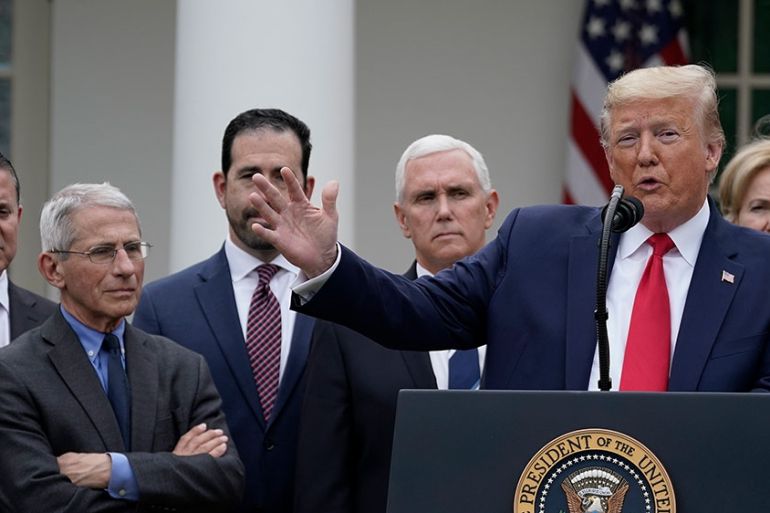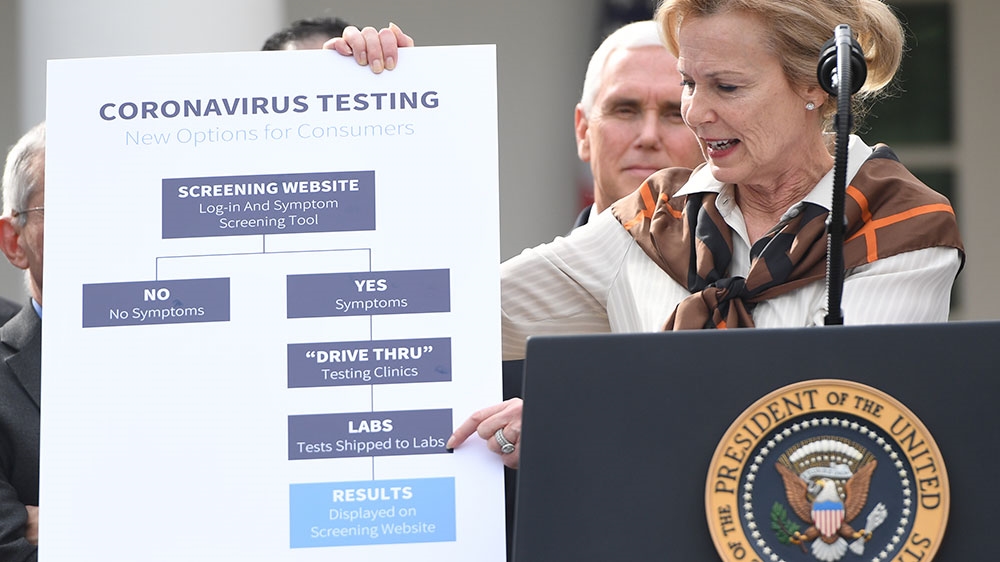Trump declares national emergency as coronavirus crisis deepens
The declaration comes amid criticism over the Trump administration’s response to the coronavirus pandemic.

As the coronavirus pandemic tore deeper into the fabric of American public life, United States President Donald Trump declared a national emergency on Friday to provide more money to fight a pandemic that has killed 41 people in the US.
“I am officially declaring a national emergency,” he said from the White House’s Rose Garden.
Keep reading
list of 3 itemsCoronavirus: Which countries have confirmed cases?
What happens if you catch the new coronavirus?
The declaration of a national emergency, a rarely used presidential power, allows the Federal Emergency Management Agency to assist state and local governments and coordinate the nation’s response to the crisis.
Trump said the declaration would free up to $50bn for state and local governments to respond to the outbreak.
Trump said he was also giving Secretary of Health and Human Services Alex Azar emergency authorities to waive federal regulations and laws to give doctors and hospitals “flexibility” in treating patients.
The move follows an unprecedented cascade of shutdowns this week, from sports events to museums and workplaces, that is aimed at limiting large public gatherings to help slow the fast-spreading virus.
From lack of testing to an initial downplaying of the threat, the Trump administration has faced harsh criticism over its response to virus.
On Friday, Trump announced that the US will “vastly increase” its testing capacity.
Among the steps being taken was a public-private partnership to create drive-through testing options. Trump, however, said that US authorities do not want people to get a coronavirus test if they do not need it.
“It’s totally unnecessary,” Trump said. He added, “This will pass.”
Trump said the administration planned to announce on Sunday night further details of the testing options, including a screening website where individuals could go to see if they should be tested and how to get tested.

New York had already said it would begin drive-through testing for coronavirus in New Rochelle, a suburb of New York City where authorities have set up a one-mile (1.6km) “containment zone” around an infection hot spot.
“It’s safer to keep them in their car, it’s less exposure overall,” Governor Andrew Cuomo told a news conference on Friday.
Coronavirus has hit New York, California and Washington states particularly hard, but all but a few states have announced cases of the respiratory illness.
Death toll surpasses 41
The US Centers for Disease Control and Prevention (CDC) on Friday reported 1,678 US cases of coronavirus, an increase of 414 from its previous count, and said that the number of deaths had risen by five to 41. The CDC tally includes 49 cases among people repatriated from Japan and Wuhan, China, where the outbreak began. It has since spread to more than 130 countries and territories, infecting over 138,000 people worldwide, according to the World Health Organization.
Across the US, shoppers preparing to hunker down at home hit stores in droves to stockpile supplies of food and other essentials such as toilet paper, cookies, pasta and paper towels as coronavirus concerns stoked fears of shortages.
As Trump made the emergency declaration, a congressional aid package to limit the economic damage of the crisis hung in the balance.
Democrats, who control the House of Representatives, had previously said they were close to an agreement after negotiating through the night with Treasury Secretary Steven Mnuchin, Trump’s point person on the issue.
House Speaker Nancy Pelosi said on Friday that the House would approve its coronavirus aid package, imploring the Trump administration and congressional Republicans to “put families first” by backing the effort to provide Americans with relief.
The House Democratic leader spoke from the speaker’s balcony at the Capitol ahead of Trump’s news conference at the White House, as the power centres of Washington, DC, were shuttered to visitors.
“Our nation, our great nation has faced crisis before,” Pelosi said. “And every time, thanks to the courage and optimism of the American people, we have prevailed. Now, working together, we will once again prevail.”
Republicans said they were waiting for the president to give his approval and had yet to commit. Without their support, the measure could stall in the Senate.
Trump said on Friday that he did not think the Democrats were giving enough as part of its package.
Mnuchin has proposed a variety of tax breaks, while Democrats called for expanding the safety net to help those who may lose work as schools close, sports arenas sit empty and airlines cancel flights.